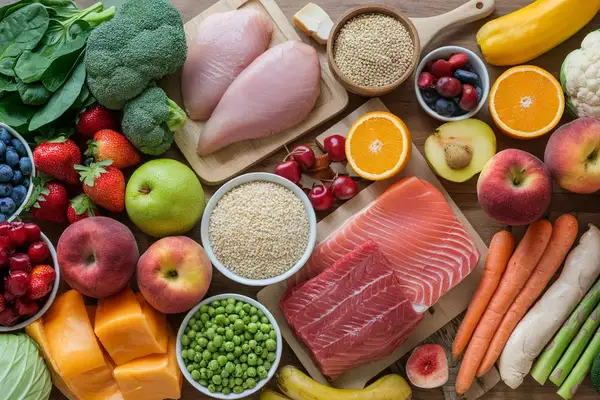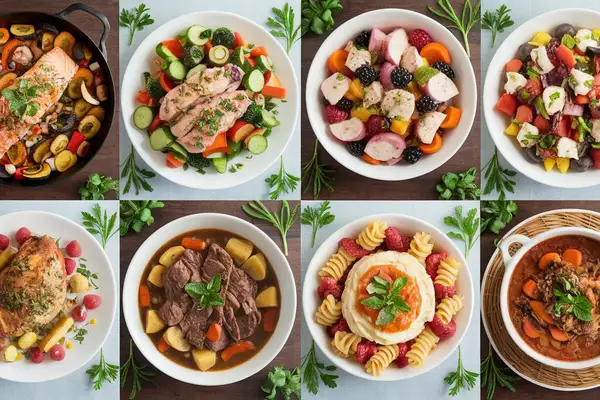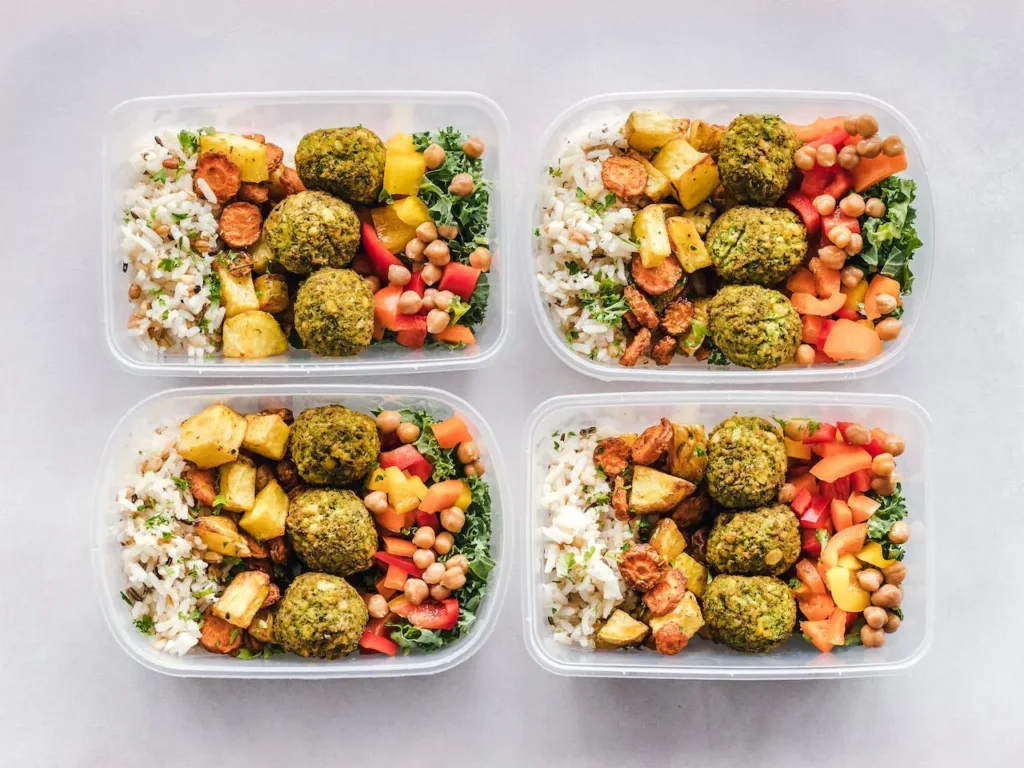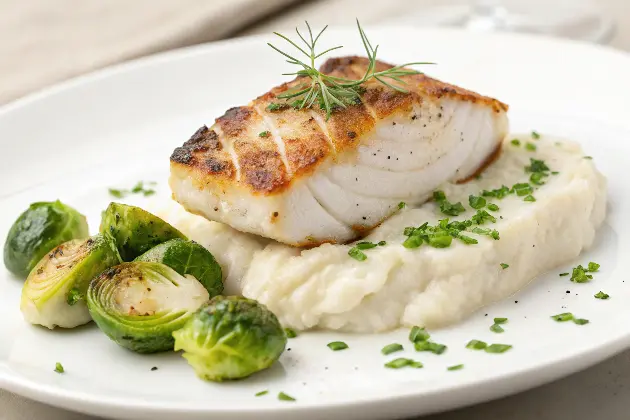8 Reasons Why Paleo Diet is Unhealthy | Paleo Diet Plan
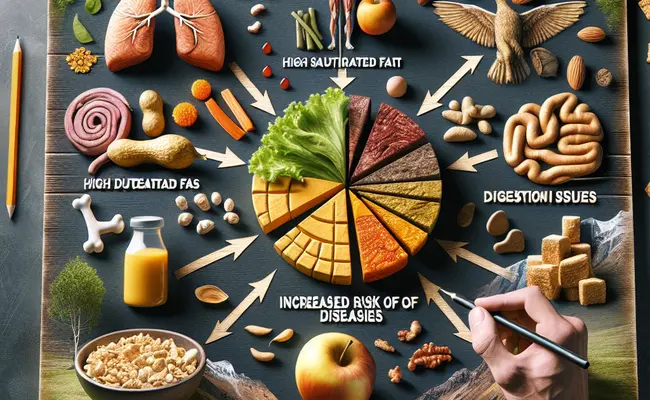
This post may contain affiliate links, meaning I may earn a commission if you make a purchase, at no extra cost to you. I only recommend products I trust. Thank you for your support.
The Paleo diet, also known as the “caveman diet,” is a dietary approach that aims to mimic the eating habits of our Paleolithic ancestors.
The Paleo diet is based on the premise of consuming foods that our ancestors would have hunted or gathered, aiming to support a more natural way of eating that aligns with our evolutionary biology.
However, the validity of this diet has been a subject of much debate, with many experts questioning its long-term sustainability and potential health risks.
This article covers why Paleo diet is unhealthy, Paleo diet pros and cons, Paleo diet food list, and provides you with the Paleo diet 7-day meal plan.
What is Paleo Diet?
The Paleo diet, short for “Paleolithic diet,” is based on the idea of eating foods that our ancient ancestors might have eaten during the Paleolithic era, which lasted from approximately 2.5 million to 10,000 years ago.
The caveman diet emphasizes that our bodies are genetically adapted to the diet of our hunter-gatherer ancestors.
This Paleo diet plan features whole, unprocessed foods such as meat, fish, eggs, vegetables, fruits, nuts, and seeds while excluding grains, legumes, dairy products, and processed foods.
Why Paleo Diet is Unhealthy (Cons of the Paleo Diet)
Despite its growing popularity, the Paleo diet has been criticized by many health professionals for its potential downsides.
Here are some reasons why Paleo diet is unhealthy:
1. Nutrient Deficiencies:
- The Paleo diet typically excludes dairy products, which are primary sources of calcium and vitamin D in many diets which can lead to osteoporosis and other bone-related issues.
- The Paleo diet excludes grains and legumes which are rich sources of B vitamins (B1, B2, B3, and folate) and fiber which can lead to deficiencies in energy levels, brain function, and digestion.
2. High Saturated Fat Intake:
- The Paleo diet is often high in saturated fats and cholesterol, which can contribute to an increased risk of heart disease, stroke, and elevated cholesterol levels.
3. Digestive Issues:
- The exclusion of grains and legumes, which are rich in fiber, can lead to digestive problems such as constipation, bloating, and diarrhea.
4. Increased Risk of Chronic Diseases:
- Excess protein intake from animal sources, particularly red meat, can lead to elevated levels of insulin-like growth factor 1 (IGF-1), associated with increased risk of cancer, diabetes, and overall mortality.
5. Potential for Fatigue:
- Poorly planned Paleo diets that are too restrictive in terms of calorie and nutrient intake, particularly carbohydrates, may lead to low energy levels and fatigue.
6. Potential Kidney Strain:
- Emphasizing meat and protein can lead to overconsumption of protein, which can strain the kidneys and liver, especially in individuals with preexisting conditions.
7. Too Restrictive:
- The strict elimination of various food groups can make the diet difficult to maintain long-term. This restrictive nature can lead to social isolation, stress, and a negative relationship with food.
8. Lack of Scientific Consensus:
- Critics argue that the diet is based on a simplistic view of ancient diets and does not account for the diversity and evolution of human dietary practices over millennia.
The Pros of the Paleo Diet
While the Paleo diet has its drawbacks, it also has several potential benefits of the Paleo diet that attract many followers.
Here are some of the key pros of the Paleo diet:
1. Improved Blood Sugar Control:
- By eliminating refined sugars and processed grains, the Paleo diet can help stabilize blood sugar levels. This is particularly beneficial for people with insulin resistance or type 2 diabetes.
2. Weight Loss and Management:
- The diet’s emphasis on protein-rich foods can promote satiety, reducing overall calorie intake and aiding in weight loss.
- Eliminating processed foods, which are often high in empty calories and unhealthy fats, can contribute to weight management.
3. Improved Insulin Sensitivity:
- Studies have indicated that adhering to the Paleo diet may lead to improved insulin sensitivity, a key factor in diabetes management.
4. Lower Blood Pressure:
- Preliminary research has suggested that the Paleo diet might contribute to lower blood pressure, which is essential for cardiovascular health.
5. Reduced Inflammation:
- Many foods promoted by the Paleo diet, such as fish, fruits, vegetables, nuts, and seeds, have anti-inflammatory properties that can help manage chronic diseases and improve overall health.
6. Improved Satiety:
- A diet high in protein and healthy fats can increase feelings of fullness and reduce cravings for unhealthy snacks, which can help in maintaining a healthy weight and avoiding overeating.
7. Possible Reduction in Allergens:
- The Paleo diet eliminates dairy, grains, and legumes, which are common allergens or intolerances for many people, leading to improved gastrointestinal health and reduced symptoms for those with sensitivities.
Paleo Diet 7-Day Meal Plan (Caveman Diet Recipes)
This Paleo diet 7-day meal plan offers a variety of easy paleo recipes from lean proteins, healthy fats, and a rainbow of fruits and vegetables, staying true to the Paleo diet rules.
Keep in mind that individual dietary needs and preferences may vary, so feel free to adjust portions and substitute items as needed.
Here is an example of a Paleo diet 7-day meal plan or a Paleo diet meal plan:
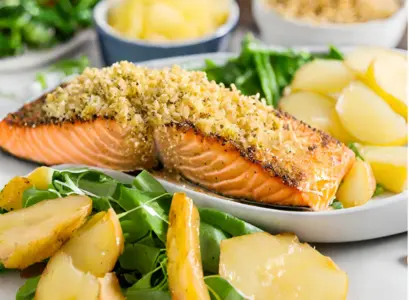
Day 1
Breakfast
- Scrambled eggs with spinach and mushrooms cooked in coconut oil.
Lunch
- Grilled chicken breast with a side of roasted sweet potatoes and steamed broccoli.
Dinner
- Baked salmon with lemon and herbs, served with a mixed green salad (spinach, kale, cucumber, tomatoes) dressed with olive oil and balsamic vinegar.
Snack
- Apple slices with almond butter.
- Almonds and a banana.
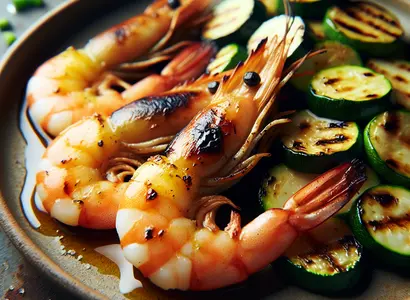
Day 2
Breakfast
- Omelette with bell peppers, onions, and tomatoes, cooked in ghee.
Lunch
- Beef stir-fry with broccoli, cauliflower, and carrots in coconut aminos sauce.
Dinner
- Grilled shrimp skewers with zucchini and bell peppers, served with a side of roasted Brussels sprouts.
Snacks
- Handful of mixed berries (strawberries, blueberries, raspberries).
- Celery sticks with almond butter.
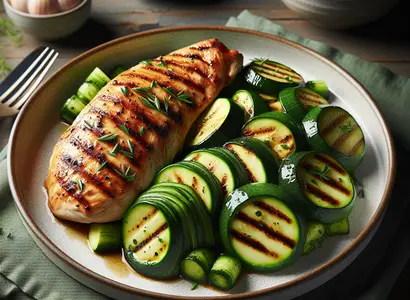
Day 3
Breakfast
- Smoothie made with coconut milk, banana, spinach, and chia seeds.
Lunch
- Turkey lettuce wraps with avocado, cucumber, and tomato.
Dinner
- Baked chicken thighs or breast with rosemary and garlic, accompanied by roasted zucchini, carrots and parsnips.
Snacks
- Hard-boiled quail eggs.
- Mixed nuts (almonds, walnuts, cashews).
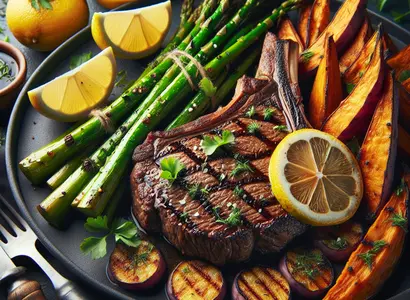
Day 4
Breakfast
- Paleo pancakes made with almond flour, topped with fresh berries and a drizzle of honey.
Lunch
- Grilled bison steak with lemon and herbs, served with a side of roasted sweet potato wedges and asparagus.
Dinner
- Baked trout with lemon and herbs, paired with a mixed green salad and pumpkin seeds.
Snacks
- Sliced apple with a sprinkle of cinnamon.
- Carrot sticks with guacamole.
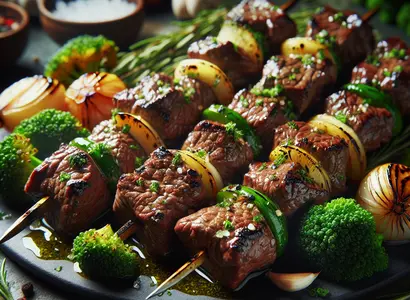
Day 5
Breakfast
- Scrambled duck eggs with sautéed spinach and mushrooms in coconut oil.
Lunch
- Grass-fed beef kabobs marinated in olive oil, garlic, and herbs, grilled to perfection. Serve with roasted broccoli.
Dinner
- Grilled lamb chops with roasted asparagus and a side of mashed cauliflower.
Snacks
- A handful of Brazil nuts.
- Fresh melon slices (watermelon, cantaloupe).
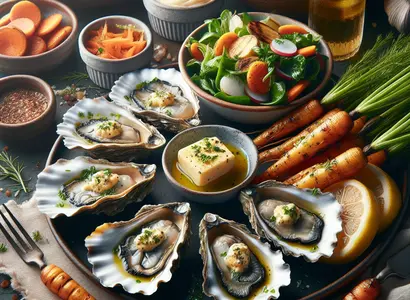
Day 6
Breakfast
- Quail egg omelette with bell peppers and onions cooked in ghee.
Lunch
- Steamed mussels in a garlic and herb broth, served with roasted Brussels sprouts and a side of mixed greens salad with avocado slices.
Dinner
- Grilled oysters with garlic and herb butter, served with roasted carrots and parsnips and a side of mixed greens salad with a lemon vinaigrette.
Snacks
- Pumpkin seeds and a peach.
- Carrot sticks with almond butter.
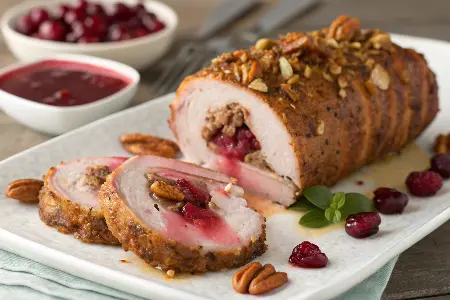
Day 7
Breakfast
- Smoothie bowl topped with sliced bananas, strawberries, and chia seeds.
Lunch
- Grilled shrimp Caesar salad with romaine lettuce, cherry tomatoes, and homemade Paleo Caesar dressing.
Dinner
- Pork tenderloin with roasted vegetables (carrots, beets, sweet potato wedges).
Snacks
- Hard-boiled chicken eggs.
- Celery sticks with almond butter.
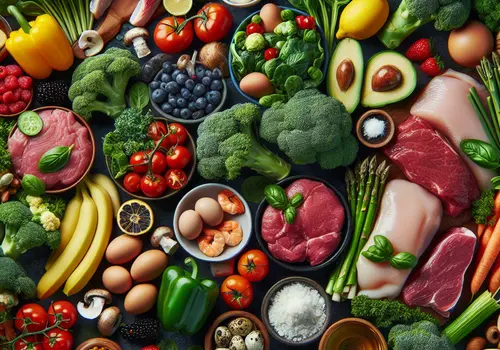
Paleo Diet Food List
The Paleo diet emphasizes whole, unprocessed foods and excludes foods that became common with the advent of agriculture and industrialization.
Here is the Paleo diet food list or the food list for Paleo diet:
1. Meats and Fish
- Lean Meats: Grass-fed beef, lamb, chicken, turkey, pork.
- Game Meats: Venison, bison, elk, goose.
- Fish and Seafood: Salmon, mussels, trout, haddock, shrimp, cod, oysters, crab, scallops, shellfish (such as crab, lobster, and clams).
2. Vegetables
- Leafy Greens: Spinach, kale, collard greens, swiss chard.
- Cruciferous Vegetables: Broccoli, cauliflower, Brussels sprouts, cabbage.
- Root Vegetables: Carrots, beets, sweet potatoes, turnips.
- Nightshade Vegetables: Bell peppers, tomatoes, eggplants (in moderation).
- Other Vegetables: Asparagus, zucchini, cucumbers, celery, mushrooms.
3. Fruits
- Apples.
- Bananas.
- Berries (strawberries, blueberries, raspberries, blackberries).
- Citrus fruits (oranges, lemons, limes).
- Grapes.
- Peaches.
- Pears.
- Melons (watermelon, cantaloupe, honeydew).
4. Nuts and Seeds
- Nuts: Almonds, walnuts, cashews, macadamia nuts, Brazil nuts, pecans.
- Seeds: Chia seeds, flaxseeds, pumpkin seeds, sunflower seeds.
5. Eggs
- Chicken eggs.
- Duck eggs.
- Quail eggs.
6. Natural Fats and Oils
- Animal Fats: Lard, tallow.
- Plant-based Oils: Olive oil, coconut oil, avocado oil.
- Other Fats: Ghee (clarified butter).
7. Herbs and Spices
- Fresh Herbs: Basil, cilantro, parsley, rosemary, thyme, oregano, dill.
- Dried Spices: Cumin, coriander, turmeric, paprika, cinnamon, black pepper, ginger, garlic.
8. Natural Sweeteners (in moderation)
- Honey.
- Maple syrup.
9. Beverages
- Water.
- Herbal teas.
- Coconut water.
Foods to Avoid on Paleo Diet
The Paleo diet avoids a variety of foods that are considered to be products of modern agriculture and food processing.
Here is a detailed list of foods to avoid on Paleo diet:
1. Grains:
- Wheat: Including products like bread, pasta, and cereals.
- Rice: Both white and brown rice.
- Oats: Including oatmeal and granola.
- Corn: Including corn products like cornmeal, tortillas, and popcorn.
- Barley and Rye: Other grains used in various processed foods.
2. Legumes:
- Beans: Including black beans, kidney beans, pinto beans, and chickpeas.
- Lentils: All varieties of lentils.
- Peas: Including green peas and split peas.
- Peanuts: Often considered legumes, including peanut butter.
- Soybeans: Including tofu, soy milk, and other soy products.
3. Dairy Products:
- Milk: All types, including whole, skim, and flavored milk.
- Cheese: All varieties.
- Yogurt: Including Greek yogurt and flavored yogurts.
- Butter and Cream: Typically avoided unless specifically opting for grass-fed butter in some variations of the diet.
4. Processed Foods:
- Processed Snacks: Such as chips, crackers, and packaged snack foods.
- Pre-packaged Meals: Including frozen dinners and boxed meals.
- Sodas and Sugary Beverages: Including diet sodas and sugary fruit drinks.
5. Refined Oils and Trans Fats:
- Vegetable Oils: Such as canola oil, corn oil, grapeseed oil, soybean oil, and sunflower oil.
- Margarine and Hydrogenated Oils: Often containing trans fats.
6. Certain Starchy Vegetables:
- White Potatoes: Sometimes excluded, though this varies among different Paleo practitioners.
- Cassava root.
- Yams.
7. Processed Meats:
- Deli Meats: Including ham, turkey, and salami.
- Sausages: Especially those containing added sugars and fillers.
- Hot Dogs: Often containing preservatives and fillers.
- Bacon: Typically avoided if cured with sugar or preservatives.
8. Alcohol:
- Beer: Made from grains.
- Certain Spirits and Liqueurs: Especially those containing added sugars or derived from grains.
- Sweetened Cocktails: Typically contain high amounts of added sugars.
9. Certain Packaged Condiments and Sauces:
- Ketchup: Often contains added sugars.
- Barbecue Sauce: Typically high in sugar.
- Certain Salad Dressings: Often contain added sugars and unhealthy oils.
10. Refined Sugars:
- White sugar.
- Brown sugar.
- Artificial sweeteners.
Conclusion
While the Paleo diet has some potential benefits, such as an increased intake of whole, unprocessed foods and reduced inflammation, it also has several drawbacks that make it an unhealthy choice for many individuals.
The restrictive nature of the diet can lead to nutrient deficiencies, increased risk of heart disease, digestive issues, and potential kidney strain.
Additionally, the strict adherence to a diet based on the eating patterns of our Paleolithic ancestors fails to account for the evolution of both humans and food sources over time.
Therefore, while the Paleo diet may offer some short-term advantages, it is crucial for individuals to carefully consider the potential risks and consult with a healthcare professional before adopting this dietary approach.
Further research is needed to fully comprehend the broader health implications of the Paleo diet
This article fully covers why paleo diet is unhealthy while also discussing the Paleo diet pros and cons. It includes a Paleo diet food list together with a Paleo diet 7-day meal plan for those interested in trying it out.
- Benefits of pineapple for men
- Taylor swift’s diet and workout plan
- 50 soft foods to eat after oral surgery
- How to stop GERD cough fast
- What happens if ozempic is not refrigerated before first use?
- How to make sea moss gel
- Is corn good for weight loss?
- 7 foods to avoid with pituitary tumor
- 7-day acid reflux diet plan
- 7-day GOLO diet plan for weight loss
- Can dogs eat avocado?
FAQs
Is the Paleo diet healthy?
The Paleo diet has both potential benefits and drawbacks. While it encourages the consumption of whole, nutrient-dense foods, it can also lead to nutrient deficiencies, increased risk of heart disease, digestive issues, and potential kidney strain.
Paleo diet Vs Dash diet?
The Paleo diet focuses on consuming whole foods like lean meats, fish, fruits, vegetables, nuts, and seeds, while avoiding processed foods, grains, dairy, and legumes. It aims to mimic the diet of early humans.
In contrast, the DASH diet emphasizes fruits, vegetables, whole grains, lean proteins, and low-fat dairy while reducing sodium intake. It’s designed to lower blood pressure.
Is Paleo diet safe for people with kidney issues?
The high protein intake associated with the Paleo diet can put additional strain on the kidneys, especially for individuals with pre-existing kidney conditions or those who are prone to kidney stones.
Does Paleo diet promote weight loss?
The Paleo diet’s emphasis on whole foods and avoidance of processed items may lead to weight loss initially. However, concerns arise regarding its long-term effectiveness and sustainability for maintaining weight loss.
Are there concerns about the Paleo diet and heart health?
Critics of the Paleo diet express concerns about its potential impact on heart health due to its high intake of red meat and saturated fats. They argue that these dietary components may increase cholesterol levels and cardiovascular risks
Resources
Here are five studies that discuss why the Paleo diet may be unhealthy:
- Paleo diet for weight loss review
- A Paleolithic-type diet results in iodine deficiency
- Effect of the Paleo Diet vs. Healthy Diets
- Influence of Paleo diet in chronic diseases
Disclaimer: The information provided in this article is for educational purposes only and should not be considered medical advice.
Before making any significant changes to your diet or lifestyle, consult with a qualified healthcare professional or nutritionist to ensure it aligns with your individual health needs and goals.
